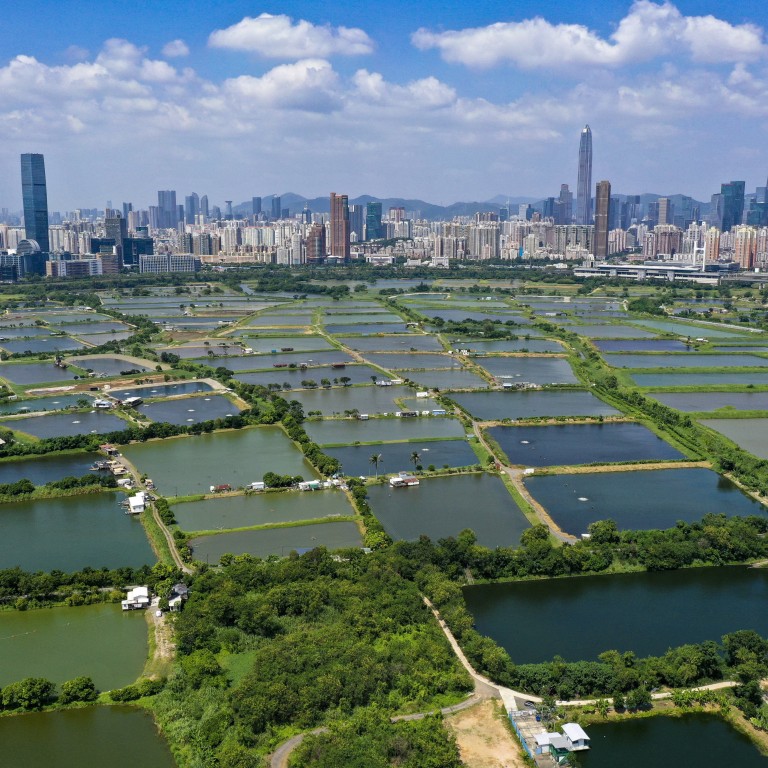
Budget 2022-23: Hong Kong to set aside HK$100 billion for ambitious Northern Metropolis plan – but studies on several key sites still unfinished
- Finance chief Paul Chan says dedicated fund of HK$100 billion under the city’s Capital Works Reserve Fund will be ploughed into the mega project
- Government source reveals that concrete plans have not yet been made on how the money will be spent
Hong Kong will set aside HK$100 billion (US$12.8 billion) for its ambitious plan to develop a vast metropolis near the mainland Chinese border although studies on several key sites have either not yet started or are still to be completed.
The metropolis plan, first unveiled in Chief Executive Carrie Lam Cheng Yuet-ngor’s policy address last October, aims to turn parts of the rural areas near the border with Shenzhen into an economic and residential hub housing 2½ million people.
From vouchers to rent relief: 7 takeaways from Hong Kong’s 2022-23 budget
The blueprint includes the existing towns of Fanling and Sheung Shui, as well as neighbouring rural areas and six new development zones under planning or construction.
To pave the way for the implementation of infrastructure works related to land, housing and transport, Chan said a dedicated fund of HK$100 billion under the city’s Capital Works Reserve Fund would be ploughed into the mega project.
A government source said concrete plans had not yet been made on how the money would be spent, as preliminary studies of areas including San Tin, Lo Wu and Man Kam To were still not completed.

For the Ma Tso Lung and Lau Fau Shan area, funding requests for relevant studies have not yet been submitted to the Legislative Council.
The source added that the funding was reserved so they would not have to bargain or compete with other departments for resources, but it did not mean the entire metropolis project would only require HK$100 billion to be completed.
Chiu Kam-kuen, international director and chief executive for Greater China at consultancy Cushman & Wakefield, said it was difficult to determine whether HK$100 billion was enough for the mega project as no details of the plan had been revealed.
“Five additional railway lines for the Northern Metropolis have been proposed but we still don’t know how complicated the projects will be and the costs involved,” he said.
Hong Kong finance chief unveils HK$170 billion budget, packed with sweeteners
Chiu added that if the government adopted a public‑private partnership approach and asked developers to help with land formation work and building supporting facilities, the cost of the whole metropolis could possibly be reduced.
The finance chief also mentioned in his budget that the government would submit bills to amend town planning and other laws to ensure timely completion of the housing projects.
The government earlier said it would seek to finish the project in 15 years.
As it happened: Hong Kong budget – spending vouchers, SMEs' 6-month rental relief
The source said another massive project, Lantau Tomorrow Vision, under which 1,000 hectares of artificial islands will be built in the waters east of Lantau Island and west of Hong Kong Island, was also targeted for completion a year early after streamlining procedures.
The government hopes to commence the first phase of reclamation in 2026 with the first batch of people moving there in 2033, a year earlier than initially planned. Different financing options for the projects including bond issuances or public‑private partnerships will be considered.

Meanwhile, the land sale programme for the coming financial year will cover 13 residential sites able to provide 8,000 flats, up from 6,000 last year. It is the fifth consecutive year that the number will be below 10,000.
Along with private redevelopment projects and property sites along railway lines, the potential supply of private housing land will increase 9 per cent from last year to about 18,000 homes. Revenue from land premiums is estimated to be HK$120 billion, a 15 per cent fall compared with the revised estimate for last year.
The completion of private flats is estimated at an average of more than 19,000 annually in the five years from 2022, an increase of about 14 per cent over the annual average of the past five years.
Hong Kong residents to receive HK$10,000 in e-vouchers, but is cash better for some?
However, the head of land and housing research at the think tank Our Hong Kong Foundation Ryan Ip Man-ki said the completion target had only been met twice in the past five years.
Ip suggested the government could leverage on the private sector, for example by charging land premiums at standard rates for agricultural sites, rather than using a ladder of rates for different classes of land, to attract developers to convert farmland for housing.
Four commercial sites will also be made available for sale, yielding only 300,000 square metres, a drop of 37.5 per cent from last year.
The secretary for development will hold a press conference on the land sale programme on Thursday.

